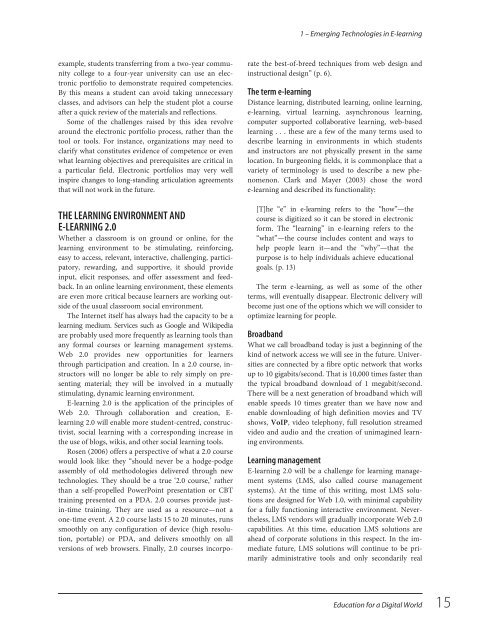Education for a Digital World Advice, Guidelines and Effective Practice from Around Globe, 2008a
Education for a Digital World Advice, Guidelines and Effective Practice from Around Globe, 2008a
Education for a Digital World Advice, Guidelines and Effective Practice from Around Globe, 2008a
You also want an ePaper? Increase the reach of your titles
YUMPU automatically turns print PDFs into web optimized ePapers that Google loves.
1 – Emerging Technologies in E-learning<br />
example, students transferring <strong>from</strong> a two-year community<br />
college to a four-year university can use an electronic<br />
portfolio to demonstrate required competencies.<br />
By this means a student can avoid taking unnecessary<br />
classes, <strong>and</strong> advisors can help the student plot a course<br />
after a quick review of the materials <strong>and</strong> reflections.<br />
Some of the challenges raised by this idea revolve<br />
around the electronic portfolio process, rather than the<br />
tool or tools. For instance, organizations may need to<br />
clarify what constitutes evidence of competence or even<br />
what learning objectives <strong>and</strong> prerequisites are critical in<br />
a particular field. Electronic portfolios may very well<br />
inspire changes to long-st<strong>and</strong>ing articulation agreements<br />
that will not work in the future.<br />
THE LEARNING ENVIRONMENT AND<br />
E-LEARNING 2.0<br />
Whether a classroom is on ground or online, <strong>for</strong> the<br />
learning environment to be stimulating, rein<strong>for</strong>cing,<br />
easy to access, relevant, interactive, challenging, participatory,<br />
rewarding, <strong>and</strong> supportive, it should provide<br />
input, elicit responses, <strong>and</strong> offer assessment <strong>and</strong> feedback.<br />
In an online learning environment, these elements<br />
are even more critical because learners are working outside<br />
of the usual classroom social environment.<br />
The Internet itself has always had the capacity to be a<br />
learning medium. Services such as Google <strong>and</strong> Wikipedia<br />
are probably used more frequently as learning tools than<br />
any <strong>for</strong>mal courses or learning management systems.<br />
Web 2.0 provides new opportunities <strong>for</strong> learners<br />
through participation <strong>and</strong> creation. In a 2.0 course, instructors<br />
will no longer be able to rely simply on presenting<br />
material; they will be involved in a mutually<br />
stimulating, dynamic learning environment.<br />
E-learning 2.0 is the application of the principles of<br />
Web 2.0. Through collaboration <strong>and</strong> creation, E-<br />
learning 2.0 will enable more student-centred, constructivist,<br />
social learning with a corresponding increase in<br />
the use of blogs, wikis, <strong>and</strong> other social learning tools.<br />
Rosen (2006) offers a perspective of what a 2.0 course<br />
would look like: they “should never be a hodge-podge<br />
assembly of old methodologies delivered through new<br />
technologies. They should be a true ‘2.0 course,’ rather<br />
than a self-propelled PowerPoint presentation or CBT<br />
training presented on a PDA. 2.0 courses provide justin-time<br />
training. They are used as a resource—not a<br />
one-time event. A 2.0 course lasts 15 to 20 minutes, runs<br />
smoothly on any configuration of device (high resolution,<br />
portable) or PDA, <strong>and</strong> delivers smoothly on all<br />
versions of web browsers. Finally, 2.0 courses incorporate<br />
the best-of-breed techniques <strong>from</strong> web design <strong>and</strong><br />
instructional design” (p. 6).<br />
The term e-learning<br />
Distance learning, distributed learning, online learning,<br />
e-learning, virtual learning, asynchronous learning,<br />
computer supported collaborative learning, web-based<br />
learning . . . these are a few of the many terms used to<br />
describe learning in environments in which students<br />
<strong>and</strong> instructors are not physically present in the same<br />
location. In burgeoning fields, it is commonplace that a<br />
variety of terminology is used to describe a new phenomenon.<br />
Clark <strong>and</strong> Mayer (2003) chose the word<br />
e-learning <strong>and</strong> described its functionality:<br />
[T]he “e” in e-learning refers to the “how”—the<br />
course is digitized so it can be stored in electronic<br />
<strong>for</strong>m. The “learning” in e-learning refers to the<br />
“what”—the course includes content <strong>and</strong> ways to<br />
help people learn it—<strong>and</strong> the “why”—that the<br />
purpose is to help individuals achieve educational<br />
goals. (p. 13)<br />
The term e-learning, as well as some of the other<br />
terms, will eventually disappear. Electronic delivery will<br />
become just one of the options which we will consider to<br />
optimize learning <strong>for</strong> people.<br />
Broadb<strong>and</strong><br />
What we call broadb<strong>and</strong> today is just a beginning of the<br />
kind of network access we will see in the future. Universities<br />
are connected by a fibre optic network that works<br />
up to 10 gigabits/second. That is 10,000 times faster than<br />
the typical broadb<strong>and</strong> download of 1 megabit/second.<br />
There will be a next generation of broadb<strong>and</strong> which will<br />
enable speeds 10 times greater than we have now <strong>and</strong><br />
enable downloading of high definition movies <strong>and</strong> TV<br />
shows, VoIP, video telephony, full resolution streamed<br />
video <strong>and</strong> audio <strong>and</strong> the creation of unimagined learning<br />
environments.<br />
Learning management<br />
E-learning 2.0 will be a challenge <strong>for</strong> learning management<br />
systems (LMS, also called course management<br />
systems). At the time of this writing, most LMS solutions<br />
are designed <strong>for</strong> Web 1.0, with minimal capability<br />
<strong>for</strong> a fully functioning interactive environment. Nevertheless,<br />
LMS vendors will gradually incorporate Web 2.0<br />
capabilities. At this time, education LMS solutions are<br />
ahead of corporate solutions in this respect. In the immediate<br />
future, LMS solutions will continue to be primarily<br />
administrative tools <strong>and</strong> only secondarily real<br />
<strong>Education</strong> <strong>for</strong> a <strong>Digital</strong> <strong>World</strong> 15


















